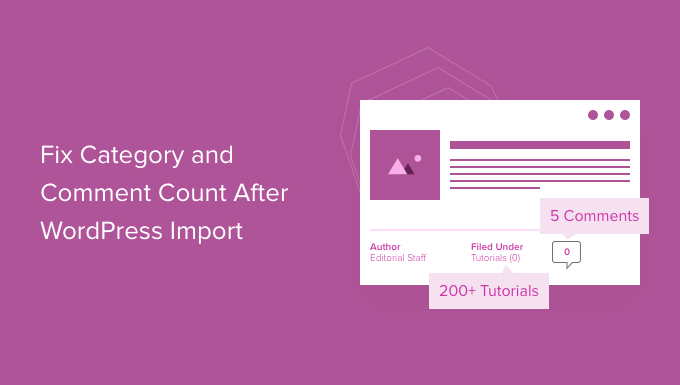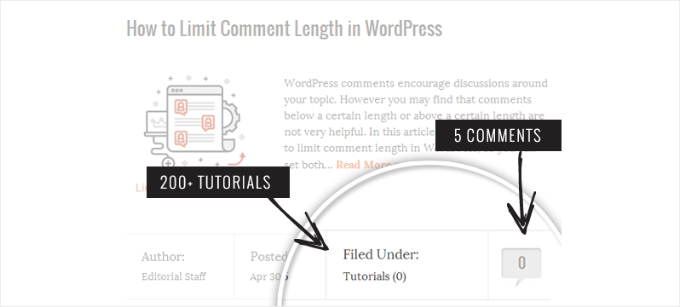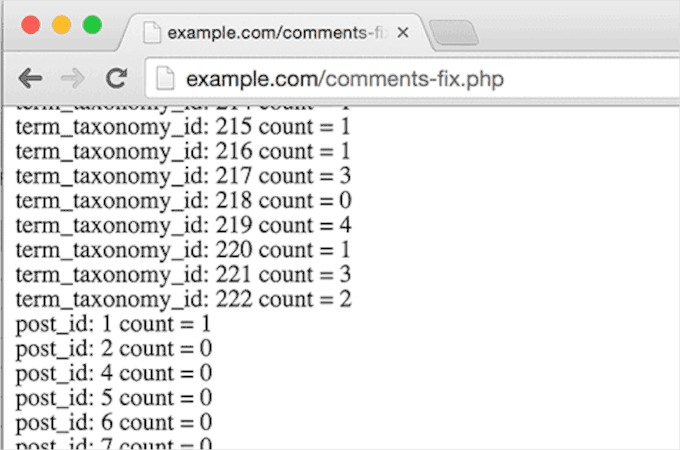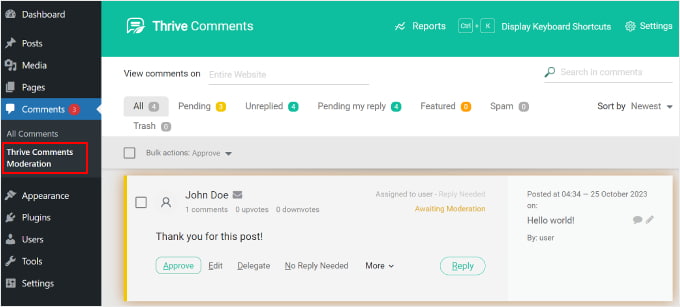Moving your WordPress site over can sometimes mess up your category and comment counts. After all that effort, seeing the wrong numbers can be pretty frustrating.
At WPBeginner, we’ve helped many different users move their websites with our WordPress migration services. Over the years, we’ve also tested various methods and found that Duplicator is the most reliable tool for a smooth import without errors.
In this article, we’ll show you how to fix your category and comment counts after WordPress import. Let’s get your site back in order! 🛠️

ℹ️ Insider Tip: Need help moving your site? Let a WPBeginner expert handle the migration for you. We’ve helped countless users transfer their WordPress sites seamlessly. Get started today – it’s free!
What Causes Category and Content Count Error in WordPress?
When you import your WordPress site using the built-in importer, it can sometimes show an inaccurate comment count or none at all.
While all the comments are safely imported and visible in the admin area, your posts might show an incorrect count on your website. This same import error can also impact the category and custom taxonomy counts.

As you noticed in the screenshot above, after the import, our comment count and category count show 0 instead of the actual number.
In the following sections, let’s look at how to fix this issue and display an accurate comments count in WordPress. Here’s a quick look at all the topics we’ll share:
Let’s get started.
Fixing Category and Comment Count in WordPress
Before we start, you’ll want to create a complete WordPress backup of your site. You should do this every time before making a major change to it.
We recommend using Duplicator because it’s the best WordPress backup plugin on the market.
We actually use Duplicator on some of our partner brands’ websites, and we’ve seen how powerful this backup plugin is. For a deeper look into the plugin, head over to our comprehensive Duplicator review.

The general steps include creating a backup, downloading the file, and setting up a disaster recovery link. For a detailed walkthrough, please see our guide on how to back up your WordPress site with Duplicator.
After creating the backup, let’s move on to the next step. You’ll need to open a plain text editor like Notepad and copy-paste the following code:
<?php
include("wp-config.php");
$myConnection = mysqli_connect(DB_HOST, DB_USER, DB_PASSWORD);
if (!mysqli_connect(DB_HOST, DB_USER, DB_PASSWORD)) { die('Could not connect: ' . mysqli_error()); }
if (!mysqli_select_db($myConnection, DB_NAME)) { die('Could not connect: ' . mysqli_error()); }
$result = mysqli_query($myConnection, "SELECT term_taxonomy_id FROM ".$table_prefix."term_taxonomy");
while ($row = mysqli_fetch_array($result)) {
$term_taxonomy_id = $row['term_taxonomy_id'];
echo "term_taxonomy_id: ".$term_taxonomy_id." count = ";
$countresult = mysqli_query($myConnection, "SELECT count(*) FROM ".$table_prefix."term_relationships WHERE term_taxonomy_id = '$term_taxonomy_id'");
$countarray = mysqli_fetch_array($countresult);
$count = $countarray[0];
echo $count."<br />";
mysqli_query($myConnection, "UPDATE ".$table_prefix."term_taxonomy SET count = '$count' WHERE term_taxonomy_id = '$term_taxonomy_id'");
}
$result = mysqli_query($myConnection, "SELECT ID FROM ".$table_prefix."posts");
while ($row = mysqli_fetch_array($result)) {
$post_id = $row['ID'];
echo "post_id: ".$post_id." count = ";
$countresult = mysqli_query($myConnection, "SELECT count(*) FROM ".$table_prefix."comments WHERE comment_post_ID = '$post_id' AND comment_approved = 1");
$countarray = mysqli_fetch_array($countresult);
$count = $countarray[0];
echo $count."<br />";
mysqli_query($myConnection, "UPDATE ".$table_prefix."posts SET comment_count = '$count' WHERE ID = '$post_id'");
}
?>
Then, don’t forget to replace DB_HOST, DB_USER, DB_PASSWORD with your WordPress database host (usually the localhost), database username, and password.
You can find all this information by logging into your WordPress hosting‘s control panel or looking at your wp-config.php file using a file manager.
Once you have replaced the information, you can save the file as comments-fix.php on your desktop.
You will now need to upload this file to your site’s root directory. You can do that using an FTP client or the file manager in your web hosting control panel.
For more information, you might want to see our step-by-step guide on using FTP to upload files to WordPress.
After uploading the file to your website, let’s open your web browser and head over to this file:
https://example.com/comments-fix.php
Don’t forget to replace example.com with your site’s address.
Visiting this file in your browser will execute the script. It will loop through your posts, categories, tags, and comments to update the count.

Now, once you’re done fixing your WordPress comment count, you need to delete comments-fix.php file from your server.
Bonus Tip: Configure Other Comment Settings
After importing your WordPress site, you might want to re-configure your comment settings.
First, you’ll want to decide whether you want to allow comments on new posts by default. Or you can just enable or disable comments for individual posts.
Moderation settings help you control the quality of comments. You can choose to approve comments manually or allow comments from trusted users to appear automatically.

Email notifications keep you updated about new comments. You can get notified whenever someone comments or when a comment needs approval. If you enable moderation, you can also notify users when their comments are approved.
Now, you might want to go to Settings » Discussion in your WordPress dashboard to configure your comment settings. However, we recommend using Thrive Comments for more advanced features.

Thrive Comments is the best WordPress comments plugin on the market. In addition to the basic configuration, it can help you engage your readers with features like upvotes, downvotes, likes, badges, and social media sharing.
For more details, don’t miss our complete Thrive review!
We hope this article helped you learn how to fix category and comment counts after WordPress import. Next, you may also want to check out our guides on how to show comments on the homepage of your WordPress theme and how to change the category order in WordPress.
If you liked this article, then please subscribe to our YouTube Channel for WordPress video tutorials. You can also find us on Twitter and Facebook.





Fitri
Mine is not working, all the count from comments-fix.php is appear, but when i go to single page product it still says Reviews(0)
WPBeginner Support
Your server may be running on a newer PHP version, this code was for php 5.5 and we will certainly take a look into what we can do to update the code.
Admin
Carlos
Thanks for this tutorial! Once I switched to PHP 5.5 the script worked like a charm.
WPBeginner Support
Glad it worked for you
Admin
Peter Edwards
I lost most of the tag counts in a recent import – fixed this by bulk editing all the posts which were tagged and clicking update (without any changes). This triggers the tag count to be updated by wordpress core. Not sure if a similar trick would work for comments?
Bonnie
Ooo, such a simple solution, and it worked! Thanks!
Kingsley Felix
anyone for duplicate comments?
Pare
Just using cPanel go to PhpMyAdmin
Check What is category id (term_id) in table “xxx_terms” and then update count value in column count into the table “xxx_term_taxonomy” where the term_id is equal term_id of xxx_terms table which that category exists on.
Forexample “uncategory” of product is term_id = 10 and count value is wrong, I update count value to be correct number in table “xxx_term_taxonomy” where term_id = 10. by manual on cPanel – PhpMyAdmin tool.
Phuc
I get an error 500 if I want to access the comments-fix.php file. How can I fix this?
WPBeginner Support
Hello,
Please see our guide on how to fix 500 internal server error.
Admin
Jay
To echo Yuriy’s comments, it’s not working for me either with PHP 7. 500 error.
Yuriy Smirnov
Doesn’t work on php7, because mysql_connect function has been removed since 7.0.0 verstion.
Rianta D. Mulyana
Thanks brother, it works!
Cosmin
Quick question: when replacing the DB_HOST, DB_USER, DB_PASSWORD and DB_NAME do we need to use “” or ” to enclose those values in? Or do we simply paste the values?
I tried and I am getting 500 Internal Server Error while accessing the uploaded file
Tyler
Yes, you do need to include single quotes around those values. Author should update the snippet to reflect that. Also, author forgot to mention that DB_NAME must also be changed.
Easy to spot, but this tutorial will fail for anyone following the instructions explicitly.
Makinde
Thanks WPBeginner, This was helpful..
Thanks for always being there for us.
Appreciate!
Aeryn Lynne
After a disastrous comment import that involved Intense Debate (only thing we could do is import bits of the xml file directly into mysql after obtaining post IDs for nearly a thousand posts,) I’m definitely in need of a quick program like this to correct the count, so thank you!
If anyone is looking to fix the comment count for one or two posts only though: instead of accessing FTP and mysql, they just need click Edit on one of the comments of the post that needs correction, and then click Update, and the post then updates the comment count for all comments involved in that post.
Naki Biga
Work like a charm, thank you very much!
Very simple and usefull code!
Edwin Rio
hi …
i have migrated one sito into another (i was using disqus for comments)
now in my new site, i can see the comments on the comments area but once i activate the disqus plugin the comments are not appearing on the front end article,
is this solution for my problem as well or my problems its most on disqus side ?
Thanks !
union
hi …
i have migrated one sito into another (i was using disqus for comments)
now in my new site, i can see the comments on the comments area but once i activate the disqus plugin the comments are not appearing on the front end article,
is this solution for my problem as well or my problems its most on disqus side ?
Thanks !
Connor Rickett
That seems fairly straightforward. Thanks for putting that code together, that’s a huge help!